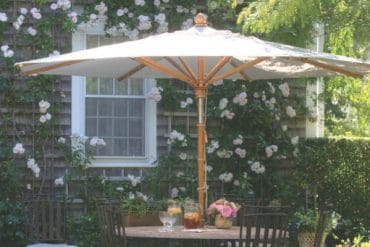Pulitzer Prize-winning architectural critic Paul Goldberger discusses the changing façade of Nantucket.
Paul Goldberger is arguably the most respected architectural critic of our time. As a fledgling writer for The New York Times, Goldberger earned a Pulitzer Prize for Distinguished Criticism, launching him into a career that would include bestselling books and posts at the top publications in the country. He’s also a longtime lover of Nantucket. Goldberger vacationed on the island with his girlfriend in 1979. By the time they boarded the ferry to the mainland, the couple were engaged and have been making regular trips to the island ever since. Last month, Goldberger was on the island as the keynote speaker at the Nantucket Preservation Trust’s annual symposium. N Magazine spoke with Goldberger about Nantucket’s architecture, past and present.
 N MAGAZINE: Given your recent trip to the island as the keynote speaker for the Nantucket Preservation Trust’s symposium, I want to start by talking about preservation. Why do you think it is so important to retain the historical identity of the island?
N MAGAZINE: Given your recent trip to the island as the keynote speaker for the Nantucket Preservation Trust’s symposium, I want to start by talking about preservation. Why do you think it is so important to retain the historical identity of the island?
GOLDBERGER: The sad truth is that if you leave a place like Nantucket alone, it will not stay the way it is—it will change. It’s a myth to think that it will stay the same. If you value Nantucket as it is, then you have to be proactive and involved to keep it the same, because nature changes things. Now if the question is why keep Nantucket the same, why not let it change, the answer is complicated.
N MAGAZINE: How so?
GOLDBERGER: You do want it to change a certain amount. I don’t believe that places like Nantucket should become museums. It’s a real place and should still feel like a real place, with real life going on. Real life implies—in fact, real life requires—some degree of change. But something you really love and want to take care of requires you to manage change. In the same way that if you just leave nature alone in a beautiful garden, you’ll soon have a pretty horrible garden. You have to manage it. The same thing is true of communities, particularly ones that have a kind of delicate, fragile perfection to them like Nantucket.
N MAGAZINE: Within that idea of managing change, do you think that Nantucket affords enough flexibility to allow for adventuresome architecture?
GOLDBERGER: I think it’s allowed for some, [but] I don’t think it’s allowed for a huge amount. I think in the last few years, there’s been a little bit more willingness to allow new architecture and to acknowledge that there is a way to make new architecture that is respectful of old and of the old environment. Respecting the spirit of a place is much more complicated than directly mimicking. There are other ways to do it. I’ve seen more interesting and subtle architecture in recent years than I had several years ago.
 N MAGAZINE: Some would say that limitations can actually inspire creativity. Do you think that’s applicable to Nantucket, wherein regulations are pushing architects to work within those limits?
N MAGAZINE: Some would say that limitations can actually inspire creativity. Do you think that’s applicable to Nantucket, wherein regulations are pushing architects to work within those limits?
GOLDBERGER: Absolutely. In fact, I’d go further and say all design is a response to some kind of constraint. I don’t think anybody does their very best work when they have a completely blank slate. All design requires some constraint. On the other hand, sometimes constraints can be so extreme as to leave no room for creativity whatsoever. And so, it then gets back to the specifics: is there room for creativity, but are the constraints still firm enough to keep things in a kind of coherent connection to the larger spirit of the place?
N MAGAZINE: Have you seen instances of that on island?
GOLDBERGER: When I was last on Nantucket three years ago, I saw a really nice house that was quite large and strikingly modern, but beautifully integrated into the larger surroundings. It felt exactly right for Nantucket and made me feel very hopeful. The house might not have been permitted a few years ago, but there was just enough loosening to allow it. It struck me as fitting in just right and made you feel that there was a little bit of fresh air.
N MAGAZINE: Is there a design element on Nantucket that you think has become a little stale?
GOLDBERGER: I think that the use of gray shingle sometimes feels a little bit excessive. But at the end of the day, it’s probably smart as a sort of safety net. Because when you cover something in gray shingles, it prevents it from being too far off—no matter what you’re doing. For me, it’s an issue of interpretation as much as anything else.
N MAGAZINE: Inside Nantucket homes, we’re seeing a trend where the aesthetic is changing from “ye olde” to now more modern. Are you seeing that in similar coastal communities around the country?
GOLDBERGER: Oh yeah absolutely. I don’t know that there’s anything wrong with that. I mean it’s the way people live now. There is a difference between altering an old, historic house and building a new house that may have a somewhat more traditional facade and a very modern open interior. You see a lot of that, and I think that’s fine. I remember when I was in Nantucket a few years ago, somebody gave me a bumper sticker that said, “Gut Fish Not Houses,” which was a whole campaign against opening up the interior of historic houses. That’s right up to a point. There are certain key houses that are super important architecturally and really should be preserved. In other cases, where it’s really the public face of the house that’s the most important and not the interior, it’s reasonable to be more lenient on changes that do not affect the exterior. Again, I feel more comfortable on a case-to-case basis than talking about that as a general principle. Yes, you can do a lot within a traditional house, but at the end of the day it’s not really how people want to live. Since we do allow inside plumbing and electricity, we’ve already established the principle that we’re not really pretending it’s an 18th century house. And so, the question then is how do you interpret that principle? Do you interpret it as meaning you can also take down a wall between a kitchen and a pantry or a kitchen and a dining room and open it up? Sometimes, yes.
 N MAGAZINE: Moving to the exterior, one of the debates happening on Nantucket when it comes to preservation is over what type of building products are acceptable. For instance, there’s new plastic trim called AZEK that’s virtually indistinguishable from real wood. Where do we draw the line between being practical and being a preservationist?
N MAGAZINE: Moving to the exterior, one of the debates happening on Nantucket when it comes to preservation is over what type of building products are acceptable. For instance, there’s new plastic trim called AZEK that’s virtually indistinguishable from real wood. Where do we draw the line between being practical and being a preservationist?
GOLDBERGER: That’s a really good question. Again that’s another one that’s not unique to Nantucket, but seems to come into particularly intense focus on Nantucket. I’ve gotten a little bit more liberal and lenient about things like that in recent years, as the quality gets better and as they are becoming harder and harder to distinguish from authentic materials. When these houses were built, they were built with the best materials that were available by people who were making practical decisions. Today, we have a whole new set of challenges. We’re really trying to sustain these houses longer than they may have ever been intended to be sustained. Some new building materials have far greater longevity than a lot of old ones. Given that Nantucket’s climate off season is not super benign, something that will help sustain it and require a little less maintenance is not necessarily a bad thing. But I do think you have to be careful. Anything that’s identifiable as plastic or what have you from twenty paces away is probably not a very smart thing to be using on Nantucket houses.
N MAGAZINE: Would you prefer to go back to the Nantucket of 1979 when you first arrived? Do you miss the charm that first attracted you to the island, or are you content with the shape of the island we have today?
GOLDBERGER: Given the enormity of the pressures on Nantucket and the fact that so much money has been pushing its way into this island, it’s miraculous it’s held its own as well as it has. Sometimes you feel like the money has been squirting at it like the jets on a power washer. It’s amazing that it hasn’t totally broken it apart. I do love some of the recent architecture that I’ve seen, showing that the island is continuing to invent itself while holding onto the basic structure of where it has been. I mean, everybody feels it’s too pressured and too crowded and all that stuff, but I would go further and ask what place isn’t these days? But it’s an interesting question. There was a lot that was wonderful about Nantucket back then. I don’t believe that any place should truly go back in time. I think living places have to move forward. The challenge is moving forward without sacrificing the best of what you had and making sure that the past remains a template for the future.






